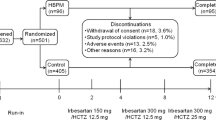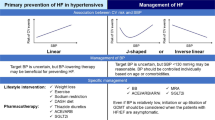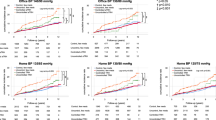Abstract
The Valsartan Amlodipine Randomized Trial (VART) was performed to compare the beneficial effects of valsartan and amlodipine on cardiovascular events in Japanese hypertensive patients. In this subanalysis of the VART, we assessed the relationship between home blood pressure (HBP) levels and cardiovascular events in the enrolled patients. We enrolled 1021 patients with mild-to-moderate hypertension in the VART. The participants were allocated randomly to either the valsartan group or the amlodipine group. The primary end point was a composite of all-cause death, sudden death, cerebrovascular events, cardiac events, vascular events and renal events. A total of 621 patients (valsartan group: 305 and amlodipine group: 316) completed the measurements of HBP (morning and evening) throughout the trial. Both the agents evenly and significantly lowered morning HBP and evening HBP throughout the trial. There was no significant difference in the primary end point between the two groups. However, we observed significant decreases in the left ventricular mass index and urinary albumin to creatinine ratio in the valsartan group but not in the amlodipine group. There were no significant differences in HBP levels and the main outcome of the cardiovascular events between the valsartan and amlodipine groups. However, in the valsartan group, significant improvements in left ventricular hypertrophy and microalbuminuria were observed.
This is a preview of subscription content, access via your institution
Access options
Subscribe to this journal
Receive 12 digital issues and online access to articles
$119.00 per year
only $9.92 per issue
Buy this article
- Purchase on Springer Link
- Instant access to full article PDF
Prices may be subject to local taxes which are calculated during checkout




Similar content being viewed by others
References
Cohn JN, Tognoni G . A randomized trial of the angiotensin-receptor blocker valsartan in chronic heart failure. N Engl J Med 2001; 345: 1667–1675.
Lindholm LH, Ibsen H, Dahlof B, Devereux RB, Beevers G, de Faire U et al. Cardiovascular morbidity and mortality in patients with diabetes in the losartan intervention for endpoint reduction in hypertension study (LIFE): a randomised trial against atenolol. Lancet 2002; 359: 1004–1010.
Pfeffer MA, Swedberg K, Granger CB, Held P, McMurray JJ, Michelson EL et al. Effects of candesartan on mortality and morbidity in patients with chronic heart failure: the CHARM-Overall programme. Lancet 2003; 362: 759–766.
Ogihara T, Nakao K, Fukui T, Fukiyama K, Ueshima K, Oba K et al. Effects of candesartan compared with amlodipine in hypertensive patients with high cardiovascular risks: candesartan antihypertensive survival evaluation in Japan trial. Hypertension 2008; 51: 393–398.
Uzu T, Sawaguchi M, Maegawa H, Kashiwagi A . Impact of renin-angiotensin system inhibition on microalbuminuria in type 2 diabetes: a post hoc analysis of the Shiga Microalbuminuria Reduction Trial (SMART). Hypertens Res 2008; 31: 1171–1176.
Kim K, Johnson JA, Derendorf H . Differences in drug pharmacokinetics between East Asians and Caucasians and the role of genetic polymorphisms. J Clin Pharmacol 2004; 44: 1083–1105.
Narumi H, Takano H, Shindo S, Fujita M, Mizuma H, Kuwabara Y et al. Effects of valsartan and amlodipine on cardiorenal protection in Japanese hypertensive patients: the valsartan amlodipine randomized trial. Hypertens Res 2011; 34: 62–69.
Tsunoda S, Kawano Y, Horio T, Okuda N, Takishita S . Relationship between home blood pressure and longitudinal changes in target organ damage in treated hypertensive patients. Hypertens Res 2002; 25: 167–173.
Ohkubo T, Asayama K, Kikuya M, Metoki H, Hoshi H, Hashimoto J et al. How many times should blood pressure be measured at home for better prediction of stroke risk? Ten-year follow-up results from the Ohasama study. J Hypertens 2004; 22: 1099–1104.
Stergiou GS, Argyraki KK, Moyssakis I, Mastorantonakis SE, Achimastos AD, Karamanos VG et al. Home blood pressure is as reliable as ambulatory blood pressure in predicting target-organ damage in hypertension. Am J Hypertens 2007; 20: 616–621.
Kario K, Matsui Y, Shibasaki S, Eguchi K, Ishikawa J, Hoshide S et al. An alpha-adrenergic blocker titrated by self-measured blood pressure recordings lowered blood pressure and microalbuminuria in patients with morning hypertension: the Japan morning surge-1 study. J Hypertens 2008; 26: 1257–1265.
Agarwal R, Bills JE, Hecht TJ, Light RP . Role of home blood pressure monitoring in overcoming therapeutic inertia and improving hypertension control: a systematic review and meta-analysis. Hypertension 2011; 57: 29–38.
Kario K, Pickering TG, Umeda Y, Hoshide S, Hoshide Y, Morinari M et al. Morning surge in blood pressure as a predictor of silent and clinical cerebrovascular disease in elderly hypertensives: a prospective study. Circulation 2003; 107: 1401–1406.
Kaneda R, Kario K, Hoshide S, Umeda Y, Hoshide Y, Shimada K . Morning blood pressure hyper-reactivity is an independent predictor for hypertensive cardiac hypertrophy in a community-dwelling population. Am J Hypertens 2005; 18: 1528–1533.
Metoki H, Ohkubo T, Kikuya M, Asayama K, Obara T, Hashimoto J et al. Prognostic significance for stroke of a morning pressor surge and a nocturnal blood pressure decline: the Ohasama study. Hypertension 2006; 47: 149–154.
Ogihara T, Kikuchi K, Matsuoka H, Fujita T, Higaki J, Horiuchi M et al. The Japanese society of hypertension guidelines for the management of hypertension (JSH 2009). Hypertens Res 2009; 32: 3–107.
Eguchi K, Matsui Y, Shibasaki S, Hoshide S, Kabutoya T, Ishikawa J et al. Controlling evening BP as well as morning BP is important in hypertensive patients with prediabetes/diabetes: the JMS-1 study. Am J Hypertens 2010; 23: 522–527.
Levy D, Garrison RJ, Savage DD, Kannel WB, Castelli WP . Prognostic implications of echocardiographically determined left ventricular mass in the framingham heart study. N Engl J Med 1990; 322: 1561–1566.
Bikkina M, Levy D, Evans JC, Larson MG, Benjamin EJ, Wolf PA et al. Left ventricular mass and risk of stroke in an elderly cohort. The framingham heart study. JAMA 1994; 272: 33–36.
Dahlof B, Devereux RB, Kjeldsen SE, Julius S, Beevers G, de Faire U et al. Cardiovascular morbidity and mortality in the losartan intervention for endpoint reduction in hypertension study (LIFE): a randomised trial against atenolol. Lancet 2002; 359: 995–1003.
Okin PM, Devereux RB, Gerdts E, Snapinn SM, Harris KE, Jern S et al. Impact of diabetes mellitus on regression of electrocardiographic left ventricular hypertrophy and the prediction of outcome during antihypertensive therapy: the losartan intervention for endpoint (LIFE) reduction in hypertension study. Circulation 2006; 113: 1588–1596.
Nagano M, Higaki J, Mikami H, Nakamaru M, Higashimori K, Katahira K et al. Converting enzyme inhibitors regressed cardiac hypertrophy and reduced tissue angiotensin II in spontaneously hypertensive rats. J Hypertens 1991; 9: 595–599.
Yamazaki T, Komuro I, Kudoh S, Zou Y, Shiojima I, Mizuno T et al. Angiotensin II partly mediates mechanical stress-induced cardiac hypertrophy. Circ Res 1995; 77: 258–265.
Yasunari K, Maeda K, Watanabe T, Nakamura M, Yoshikawa J, Asada A . Comparative effects of valsartan versus amlodipine on left ventricular mass and reactive oxygen species formation by monocytes in hypertensive patients with left ventricular hypertrophy. J Am Coll Cardiol 2004; 43: 2116–2123.
Gerstein HC, Mann JF, Yi Q, Zinman B, Dinneen SF, Hoogwerf B et al. Albuminuria and risk of cardiovascular events, death, and heart failure in diabetic and nondiabetic individuals. JAMA 2001; 286: 421–426.
Hillege HL, Fidler V, Diercks GF, van Gilst WH, de Zeeuw D, van Veldhuisen DJ et al. Urinary albumin excretion predicts cardiovascular and noncardiovascular mortality in general population. Circulation 2002; 106: 1777–1782.
Chugh A, Bakris GL . Microalbuminuria: what is it? Why is it important? What should be done about it? An update. J Clin Hypertens 2007; 9: 196–200.
Ibsen H, Olsen MH, Wachtell K, Borch-Johnsen K, Lindholm LH, Mogensen CE et al. Reduction in albuminuria translates to reduction in cardiovascular events in hypertensive patients: losartan intervention for endpoint reduction in hypertension study. Hypertension 2005; 45: 198–202.
Gaede P, Vedel P, Larsen N, Jensen GV, Parving HH, Pedersen O . Multifactorial intervention and cardiovascular disease in patients with type 2 diabetes. N Engl J Med 2003; 348: 383–393.
Jager A, Kostense PJ, Ruhe HG, Heine RJ, Nijpels G, Dekker JM et al. Microalbuminuria and peripheral arterial disease are independent predictors of cardiovascular and all-cause mortality, especially among hypertensive subjects: five-year follow-up of the Hoorn Study. Arterioscler Thromb Vasc Biol 1999; 19: 617–624.
Gerstein HC, Mann JF, Pogue J, Dinneen SF, Halle JP, Hoogwerf B et al. Prevalence and determinants of microalbuminuria in high-risk diabetic and nondiabetic patients in the heart outcomes prevention evaluation study. The HOPE study investigators. Diabetes Care 2000; 23 (Suppl 2): B35–B39.
Roest M, Banga JD, Janssen WM, Grobbee DE, Sixma JJ, de Jong PE et al. Excessive urinary albumin levels are associated with future cardiovascular mortality in postmenopausal women. Circulation 2001; 103: 3057–3061.
Andersen S, Blouch K, Bialek J, Deckert M, Parving HH, Myers BD . Glomerular permselectivity in early stages of overt diabetic nephropathy. Kidney Int 2000; 58: 2129–2137.
Trevisan R, Tiengo A . Effect of low-dose ramipril on microalbuminuria in normotensive or mild hypertensive non-insulin-dependent diabetic patients. North-East Italy microalbuminuria study group. Am J Hypertens 1995; 8: 876–883.
Imanishi M, Yoshioka K, Konishi Y, Okumura M, Okada N, Sato T et al. Glomerular hypertension as one cause of albuminuria in type II diabetic patients. Diabetologia 1999; 42: 999–1005.
Langham RG, Kelly DJ, Cox AJ, Thomson NM, Holthofer H, Zaoui P et al. Proteinuria and the expression of the podocyte slit diaphragm protein, nephrin, in diabetic nephropathy: effects of angiotensin converting enzyme inhibition. Diabetologia 2002; 45: 1572–1576.
Shiga microalbuminuria reduction trial (SMART) group Uzu T, Sawaguchi M, Maegawa H, Kashiwagi A . Reduction of microalbuminuria in patients with type 2 diabetes: the shiga microalbuminuria reduction trial (SMART). Diabetes Care 2007; 30: 1581–1583.
Wright Jr JT, Bakris G, Greene T, Agodoa LY, Appel LJ, Charleston J et al. Effect of blood pressure lowering and antihypertensive drug class on progression of hypertensive kidney disease: results from the AASK trial. JAMA 2002; 288: 2421–2431.
Parving HH, Lehnert H, Bröchner-Mortensen J, Gomis R, Andersen S, Arner P et al. The effect of irbesartan on the development of diabetic nephropathy in patients with type 2 diabetes. N Engl J Med 2001; 345: 870–878.
Sawada T, Yamada H, Dahlöf B, Matsubara H . Effects of valsartan on morbidity and mortality in uncontrolled hypertensive patients with high cardiovascular risks: KYOTO HEART study. Eur Heart J 2009; 30: 2461–2469.
Mochizuki S, Dahlöf B, Shimizu M, Ikewaki K, Yoshikawa M, Taniguchi I et al. Valsartan in a Japanese population with hypertension and other cardiovascular disease (Jikei heart study): a randomised, open-label, blinded endpoint morbidity-mortality study. Lancet 2007; 369: 1431–1439.
Acknowledgements
We thank all of the participants, physicians, medical staff and other contributors to the VART. Details of the members of the VART are as follows: Representative: Issei Komuro. Steering committee: Hiroyuki Takano, Yoichi Kuwabara, Satoshi Shindo, Keiko Nakayama, Miwa Fujita, Hiroya Narumi, Hiroshi Mizuma. Data and safety monitoring board: Toshiharu Himi (Kimitsu Chuo Hospital), Akira Aouda (Chiba Cardiovascular Center), Toru Takami (National Chiba Hospital). Event evaluation committee: Osahiro Takahashi (Chiba Aoba Municipal Hospital), Hiroyuki Niwayama (Funabashi Social Insurance Hospital), Yukinori Kohno (Chiba Social Insurance Hospital). Statistical analysis organization: Nobuo Shirahashi (Clinical Epidemiology, Osaka City University Graduate School).
Author information
Authors and Affiliations
Consortia
Corresponding author
Ethics declarations
Competing interests
The authors declare no conflict of interest.
Rights and permissions
About this article
Cite this article
Takano, H., Hasegawa, H., Narumi, H. et al. Effects of valsartan and amlodipine on home blood pressure and cardiovascular events in Japanese hypertensive patients: a subanalysis of the VART. J Hum Hypertens 26, 656–663 (2012). https://doi.org/10.1038/jhh.2011.91
Received:
Revised:
Accepted:
Published:
Issue Date:
DOI: https://doi.org/10.1038/jhh.2011.91



